Brahma Sutras (Ramanuja)
by George Thibaut | 1904 | 275,953 words | ISBN-10: 8120801350 | ISBN-13: 9788120801356
The English translation of the Brahma Sutras (also, Vedanta Sutras) with commentary by Ramanuja (known as the Sri Bhasya). The Brahmasutra expounds the essential philosophy of the Upanishads which, primarily revolving around the knowledge of Brahman and Atman, represents the foundation of Vedanta. Ramanjua’s interpretation of these sutras from a V...
Sutra 4.1.7
7. Sitting; on account of possibility.
It has been shown that that special form of cognitional activity which the Vedānta-texts set forth as the means of accomplishing final Release and which is called meditation (dhyāna; upāsana) has to be frequently repeated, and is of the nature of continued representation. A question now arises as to the way in which it has to be carried on.—There being no special restrictive rule, the Pūrvapakshin holds that the Devotee may carry it on either sitting or lying down or standing or walking.—This view the Sūtra sets aside. Meditation is to be carried on by the Devotee in a sitting posture, since in that posture only the needful concentration of mind can be reached. Standing and walking demand effort, and lying down is conducive to sleep. The proper posture is sitting on some support, so that no effort may be required for holding the body up.
